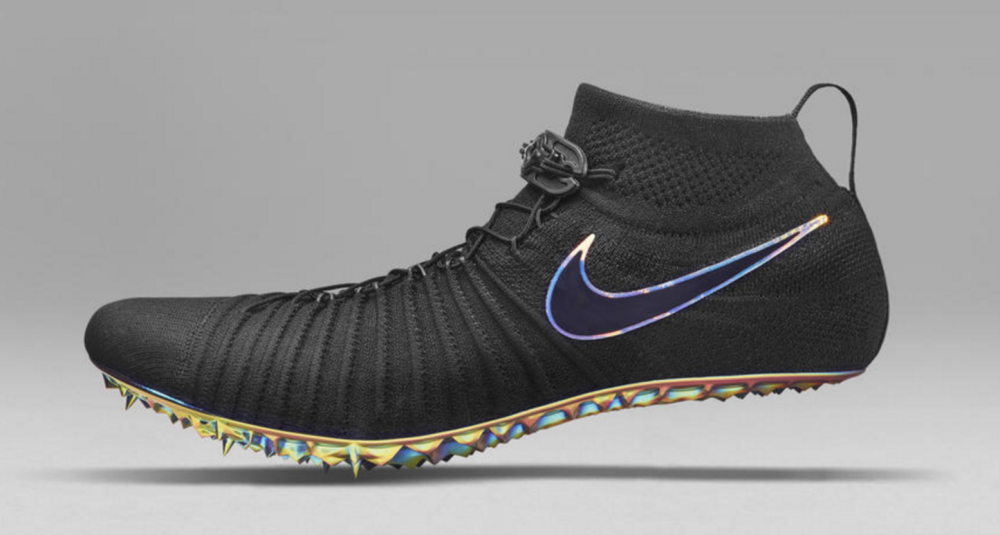Nike’s 3D Printed Sprinting Shoe the Zoom Superfly Flyknit Will be Worn at the 2016 Olympic Games in Rio
Athletes who perform in the 200- and the 400-meter sprints often win by margins of milliseconds, so they are naturally going to look for any advantage that they can find to shave a few of them off of their running times. A recent trend is ultra-lightweight running shoes with spikes on the sole of the shoe. The spikes dig into the ground, allowing the runner to push off slightly faster and have more control, while the reduced weight of the upper shoe offers drag-free movement. But a real test for runners is their ability to navigate the track’s curve, which is where most of these events are won and lost. Gold-medal-winning American sprinter Allyson Felix is hoping that a collaboration with Nike has produced the perfect set of running shoes to help her repeat her success in 2012.
 The unprecedented collaboration brought together all of Nike’s design and engineering experience, combined it with Felix’ specific insight and needs to produce a new shoe, specifically the running spikes at the bottom, that will help propel her to another victory. The Nike Zoom Superfly Flyknit is the result of exhaustive scientific analysis from Nike’s Sports Research Lab, computational design from their designers and pixel-level stitch placement from Nike Flyknit engineers. With the Nike team working closely with Felix and her team of coaches and trainers, the cutting-edge running shoe was fit with a spike plate that was precisely developed to Felix’s specifications and biomechanics.
The unprecedented collaboration brought together all of Nike’s design and engineering experience, combined it with Felix’ specific insight and needs to produce a new shoe, specifically the running spikes at the bottom, that will help propel her to another victory. The Nike Zoom Superfly Flyknit is the result of exhaustive scientific analysis from Nike’s Sports Research Lab, computational design from their designers and pixel-level stitch placement from Nike Flyknit engineers. With the Nike team working closely with Felix and her team of coaches and trainers, the cutting-edge running shoe was fit with a spike plate that was precisely developed to Felix’s specifications and biomechanics.
“One of the things that I love about the process is that I’m not an expert in this, but I have all this science behind me. This is what [Nike] does and this is what they’re passionate about. I can have confidence that they’re going to give me the best equipment,” Felix said.
Nike’s Flyknit technology is an advanced form of shoe construction that eliminates any non-essential features and reduces a typical sprinting shoe down to less than half the weight of an average running shoe. When combined with the spike plate on the bottom of the shoe, it can improve a runner’s time by several crucial seconds. The Zoom Superfly developed for Felix included the Flyknit construction, but also had a specially designed spike plate that was created to align with Felix’s preferred stiffness, flexibility and pop thanks to 3D printed rapid prototyping. The 3D designed spike plate is the first to extend to three-quarter height, which supports more of the foot, offering better traction and increased speed while turning corners.
The design process started in May 2014 at the first test-fitting, and since then Felix has met with the Nike team more than a dozen times. In total thirty different iterations of the spike plate were 3D printed using a Selective Laser Sintering (SLS) process, and the Flyknit team tweaked over seventy alternate upper designs before they had found a design that was optimized for on Felix. The final fitting for Felix’s size 9.5, AA-width sprinting shoe took place recently in Los Angeles, and in Felix’s own words, the result “feels like an extension of your foot.”
“Our role in the Innovation Kitchen is to invent the future of performance innovation for athletes. We do that with a mission to make athletes better. In this work with Allyson, the product that has been created is making her measurably better. We’re seeing faster times in practice, more efficiency through and exiting the curb as well as unprecedented feedback from Allyson. We cannot wait to see how she performs in the spike throughout the coming months,” explained the VP of Footwear Innovation at Nike, Tony Bignell.
Sadly, if you’re excited about having a pair of custom-designed running shoes like the Zoom Superfly, I’m sorry to report that this is just a one off designed for Allyson Felix. That being said, Nike didn’t do this just for fun, they were studying ways to make their running shoes better, and it is more than likely that what they learned from working with Felix is going to end up in a future pair of shoes that you will be able to purchase. Nike has been saying that the future of sports shoes are 3D printed soles and components, so it probably isn’t going to be very long before 3D printed spikes become commercially available. Until then, we’ll just have to sit back and watch Felix run herself to another gold medal this summer. Discuss in the 3D Printed Shoe Spikes forum over at 3DPB.com.
Subscribe to Our Email Newsletter
Stay up-to-date on all the latest news from the 3D printing industry and receive information and offers from third party vendors.
You May Also Like
Industrial Giant Ingersoll Rand Leads $19M Round Backing Inkbit’s AI-Driven 3D Printing
Inkbit, the Massachusetts-based original equipment manufacturer (OEM) of multi-material, AI-integrated 3D printers, has closed a $19 million financing round. Ingersoll Rand, a US giant in the industrial equipment sector, led...
3D Printing Unpeeled: Digital FDM Filament for Functional Gradients
Just published in Nature, a paper by a Seoul National University team looks at “3D printing with a 3D printed digital material filament for programming functional gradients.” Sang-Joon Ahn, Howon...
3D Printing Unpeeled: $5000 Cold Spray 3D Printer, Roland DGA & Living Materials
The AeroForge is a $5000 cold spray metal printer for copper made by a student team at Rice University. In a paper for ACS Central Science a team from Nanjing...
3D Printing News Briefs, April 27, 2024: Research, Digital Dentistry, Cycling, & More
We’re starting today’s 3D Printing News Briefs with some research into 3D printed luminescent quantum-dot polymer architectures and free-form laser beam shaping, and then on to an open source 4-axis...


































